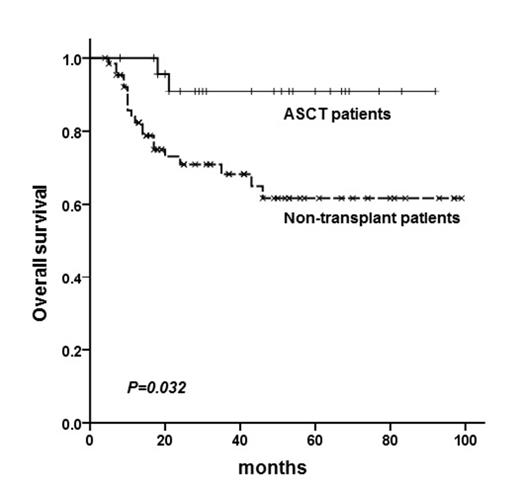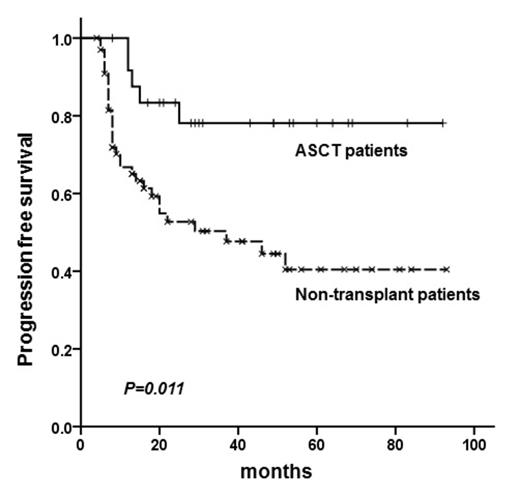Abstract
Introduction: The role of frontline autologous hematopoietic stem cell transplantation (ASCT) high-risk diffuse large B-cell lymphoma (DLBCL) is still controversial. We investigated the role of upfront ASCT as consolidation for high-risk DLBCL treated with rituximab containing chemotherapy according to molecular classification.
Methods: A total of 195 newly diagnosed DLBCL patients with advanced stage and elevated serum lactate dehydrogenase from three centers were retrospectively analyzed. All patients achieved more than partial response (PR) after completing conventional chemotherapy (cyclophosphamide, doxorubicin, vincristine, prednisone) with rituximab (R-CHOP). Molecular classification was performed according to Han's algorithm.
Results: One hundred fifty (76.9%) patients achieved complete response (CR) and 45 (23.1%) patients PR after frontline R-CHOP chemotherapy. Among these patients, sixty six (33.8%) patients were received ASCT. The 2-year overall survival (OS) was 82.9% and the 2-year progression-free survival (PFS) was 72.1%. Seven (10.6%) patients were relapsed after ASCT while 29 (22.5%) patients were relapsed in non-transplant patients. Patients who treated with ASCT showed superior OS and PFS (P=0.036, P=0.005). According to final response, ASCT showed superior OS and PFS in PR patients (P = 0.024, P = 0.009) while it did not in CR patients.
Among the 128 patients that underwent immunohistochemistry for molecular classification, 36 patients (28.1%) were classified to GCB type, 92 (72.9%) patients were non-GCB type. Twenty five (27.1%) non-GCB patients received ASCT showed significant survival benefit for OS and PFS (P=0.032, P=0.011) while GCB patients did not show the survival difference according to ASCT (Figure 1). In non-GCB DLBCL, ASCT was related with superior PFS both interim and final PR status (P = 0.006, P=0.028). There was no difference for OS and PFS between GCB and non-GCB type in ASCT patients while GCB patients showed superior OS and PFS in non-transplant patients (P = 0.048, P=0.009).
Conclusions: ASCT as consolidation improved OS and PFS in high risk DLBCL patients following R-CHOP chemotherapy. Especially, it could overcome the poor prognosis of non-GCB type DLBCL. Upfront ASCT could be considered effective treatment options for non-GCB type high risk DLBCL.
Overall survival and progression free survival according to autologous hematopoietic stem cell transplantation in non-GCB type DLBCL.
Overall survival and progression free survival according to autologous hematopoietic stem cell transplantation in non-GCB type DLBCL.
No relevant conflicts of interest to declare.
Author notes
Asterisk with author names denotes non-ASH members.



This feature is available to Subscribers Only
Sign In or Create an Account Close Modal